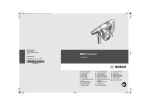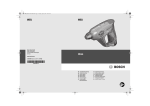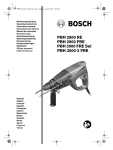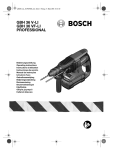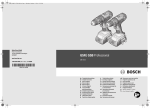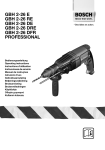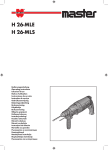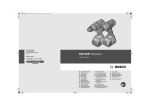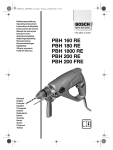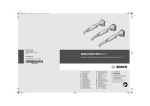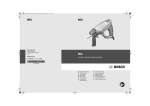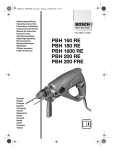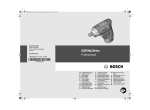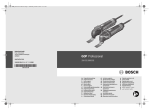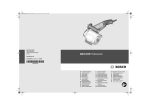Download WEU WEU PBH - Mr Bricolage
Transcript
OBJ_DOKU-28351-004.fm Page 1 Wednesday, December 3, 2014 9:43 AM WEU Robert Bosch GmbH Power Tools Division 70764 Leinfelden-Echterdingen GERMANY www.bosch-pt.com WEU PBH 2100 RE | 2100 SRE | 2500 RE | 2500 SRE 1 609 92A 0JP (2014.12) O / 89 WEU de en fr es pt it nl Originalbetriebsanleitung Original instructions Notice originale Manual original Manual original Istruzioni originali Oorspronkelijke gebruiksaanwijzing da sv no fi el tr ar Original brugsanvisning Bruksanvisning i original Original driftsinstruks Alkuperäiset ohjeet Πρωτότυπο οδηγιών χρήσης Orijinal işletme talimatı ςТЎϩХʉ ЌТϾϦφЍʉ ʌμВТЎϺυ OBJ_BUCH-1576-004.book Page 2 Wednesday, December 3, 2014 10:02 AM 2| Deutsch . . . . . . . . . . . . . . . . . . . . . . . . . . . . . . . . . . . . . . . . . Seite 3 English . . . . . . . . . . . . . . . . . . . . . . . . . . . . . . . . . . . . . . . . . . Page 8 Français . . . . . . . . . . . . . . . . . . . . . . . . . . . . . . . . . . . . . . . . . Page 14 Español . . . . . . . . . . . . . . . . . . . . . . . . . . . . . . . . . . . . . . . .Página 20 Português. . . . . . . . . . . . . . . . . . . . . . . . . . . . . . . . . . . . . . .Página 26 Italiano . . . . . . . . . . . . . . . . . . . . . . . . . . . . . . . . . . . . . . . . .Pagina 31 Nederlands . . . . . . . . . . . . . . . . . . . . . . . . . . . . . . . . . . . . .Pagina 37 Dansk . . . . . . . . . . . . . . . . . . . . . . . . . . . . . . . . . . . . . . . . . . . Side 42 Svenska . . . . . . . . . . . . . . . . . . . . . . . . . . . . . . . . . . . . . . . . . Sida 47 Norsk . . . . . . . . . . . . . . . . . . . . . . . . . . . . . . . . . . . . . . . . . . . Side 52 Suomi. . . . . . . . . . . . . . . . . . . . . . . . . . . . . . . . . . . . . . . . . . . .Sivu 57 Ελληνικά. . . . . . . . . . . . . . . . . . . . . . . . . . . . . . . . . . . . . . . . Σελίδα 62 Türkçe . . . . . . . . . . . . . . . . . . . . . . . . . . . . . . . . . . . . . . . . . Sayfa 68 .............................. 1 609 92A 0JP | (3.12.14) 80 Bosch Power Tools OBJ_BUCH-1576-004.book Page 3 Wednesday, December 3, 2014 9:44 AM Deutsch | 3 Deutsch Allgemeine Sicherheitshinweise für Elektrowerkzeuge WARNUNG Lesen Sie alle Sicherheitshinweise und Anweisungen. Versäumnisse bei der Einhaltung der Sicherheitshinweise und Anweisungen können elektrischen Schlag, Brand und/oder schwere Verletzungen verursachen. Bewahren Sie alle Sicherheitshinweise und Anweisungen für die Zukunft auf. Der in den Sicherheitshinweisen verwendete Begriff „Elektrowerkzeug“ bezieht sich auf netzbetriebene Elektrowerkzeuge (mit Netzkabel) und auf akkubetriebene Elektrowerkzeuge (ohne Netzkabel). Arbeitsplatzsicherheit Halten Sie Ihren Arbeitsbereich sauber und gut beleuchtet. Unordnung oder unbeleuchtete Arbeitsbereiche können zu Unfällen führen. Arbeiten Sie mit dem Elektrowerkzeug nicht in explosionsgefährdeter Umgebung, in der sich brennbare Flüssigkeiten, Gase oder Stäube befinden. Elektrowerkzeuge erzeugen Funken, die den Staub oder die Dämpfe entzünden können. Halten Sie Kinder und andere Personen während der Benutzung des Elektrowerkzeugs fern. Bei Ablenkung können Sie die Kontrolle über das Gerät verlieren. Elektrische Sicherheit Der Anschlussstecker des Elektrowerkzeuges muss in die Steckdose passen. Der Stecker darf in keiner Weise verändert werden. Verwenden Sie keine Adapterstecker gemeinsam mit schutzgeerdeten Elektrowerkzeugen. Unveränderte Stecker und passende Steckdosen verringern das Risiko eines elektrischen Schlages. Vermeiden Sie Körperkontakt mit geerdeten Oberflächen wie von Rohren, Heizungen, Herden und Kühlschränken. Es besteht ein erhöhtes Risiko durch elektrischen Schlag, wenn Ihr Körper geerdet ist. Halten Sie Elektrowerkzeuge von Regen oder Nässe fern. Das Eindringen von Wasser in ein Elektrowerkzeug erhöht das Risiko eines elektrischen Schlages. Zweckentfremden Sie das Kabel nicht, um das Elektrowerkzeug zu tragen, aufzuhängen oder um den Stecker aus der Steckdose zu ziehen. Halten Sie das Kabel fern von Hitze, Öl, scharfen Kanten oder sich bewegenden Geräteteilen. Beschädigte oder verwickelte Kabel erhöhen das Risiko eines elektrischen Schlages. Wenn Sie mit einem Elektrowerkzeug im Freien arbeiten, verwenden Sie nur Verlängerungskabel, die auch für den Außenbereich geeignet sind. Die Anwendung eines für den Außenbereich geeigneten Verlängerungskabels verringert das Risiko eines elektrischen Schlages. Bosch Power Tools Wenn der Betrieb des Elektrowerkzeuges in feuchter Umgebung nicht vermeidbar ist, verwenden Sie einen Fehlerstromschutzschalter. Der Einsatz eines Fehlerstromschutzschalters vermindert das Risiko eines elektrischen Schlages. Sicherheit von Personen Seien Sie aufmerksam, achten Sie darauf, was Sie tun, und gehen Sie mit Vernunft an die Arbeit mit einem Elektrowerkzeug. Benutzen Sie kein Elektrowerkzeug, wenn Sie müde sind oder unter dem Einfluss von Drogen, Alkohol oder Medikamenten stehen. Ein Moment der Unachtsamkeit beim Gebrauch des Elektrowerkzeuges kann zu ernsthaften Verletzungen führen. Tragen Sie persönliche Schutzausrüstung und immer eine Schutzbrille. Das Tragen persönlicher Schutzausrüstung, wie Staubmaske, rutschfeste Sicherheitsschuhe, Schutzhelm oder Gehörschutz, je nach Art und Einsatz des Elektrowerkzeuges, verringert das Risiko von Verletzungen. Vermeiden Sie eine unbeabsichtigte Inbetriebnahme. Vergewissern Sie sich, dass das Elektrowerkzeug ausgeschaltet ist, bevor Sie es an die Stromversorgung und/oder den Akku anschließen, es aufnehmen oder tragen. Wenn Sie beim Tragen des Elektrowerkzeuges den Finger am Schalter haben oder das Gerät eingeschaltet an die Stromversorgung anschließen, kann dies zu Unfällen führen. Entfernen Sie Einstellwerkzeuge oder Schraubenschlüssel, bevor Sie das Elektrowerkzeug einschalten. Ein Werkzeug oder Schlüssel, der sich in einem drehenden Geräteteil befindet, kann zu Verletzungen führen. Vermeiden Sie eine abnormale Körperhaltung. Sorgen Sie für einen sicheren Stand und halten Sie jederzeit das Gleichgewicht. Dadurch können Sie das Elektrowerkzeug in unerwarteten Situationen besser kontrollieren. Tragen Sie geeignete Kleidung. Tragen Sie keine weite Kleidung oder Schmuck. Halten Sie Haare, Kleidung und Handschuhe fern von sich bewegenden Teilen. Lockere Kleidung, Schmuck oder lange Haare können von sich bewegenden Teilen erfasst werden. Wenn Staubabsaug- und -auffangeinrichtungen montiert werden können, vergewissern Sie sich, dass diese angeschlossen sind und richtig verwendet werden. Verwendung einer Staubabsaugung kann Gefährdungen durch Staub verringern. Verwendung und Behandlung des Elektrowerkzeuges Überlasten Sie das Gerät nicht. Verwenden Sie für Ihre Arbeit das dafür bestimmte Elektrowerkzeug. Mit dem passenden Elektrowerkzeug arbeiten Sie besser und sicherer im angegebenen Leistungsbereich. Benutzen Sie kein Elektrowerkzeug, dessen Schalter defekt ist. Ein Elektrowerkzeug, das sich nicht mehr einoder ausschalten lässt, ist gefährlich und muss repariert werden. 1 609 92A 0JP | (3.12.14) OBJ_BUCH-1576-004.book Page 4 Wednesday, December 3, 2014 9:44 AM 4 | Deutsch Ziehen Sie den Stecker aus der Steckdose und/oder entfernen Sie den Akku, bevor Sie Geräteeinstellungen vornehmen, Zubehörteile wechseln oder das Gerät weglegen. Diese Vorsichtsmaßnahme verhindert den unbeabsichtigten Start des Elektrowerkzeuges. Bewahren Sie unbenutzte Elektrowerkzeuge außerhalb der Reichweite von Kindern auf. Lassen Sie Personen das Gerät nicht benutzen, die mit diesem nicht vertraut sind oder diese Anweisungen nicht gelesen haben. Elektrowerkzeuge sind gefährlich, wenn sie von unerfahrenen Personen benutzt werden. Pflegen Sie Elektrowerkzeuge mit Sorgfalt. Kontrollieren Sie, ob bewegliche Teile einwandfrei funktionieren und nicht klemmen, ob Teile gebrochen oder so beschädigt sind, dass die Funktion des Elektrowerkzeuges beeinträchtigt ist. Lassen Sie beschädigte Teile vor dem Einsatz des Gerätes reparieren. Viele Unfälle haben ihre Ursache in schlecht gewarteten Elektrowerkzeugen. Halten Sie Schneidwerkzeuge scharf und sauber. Sorgfältig gepflegte Schneidwerkzeuge mit scharfen Schneidkanten verklemmen sich weniger und sind leichter zu führen. Verwenden Sie Elektrowerkzeug, Zubehör, Einsatzwerkzeuge usw. entsprechend diesen Anweisungen. Berücksichtigen Sie dabei die Arbeitsbedingungen und die auszuführende Tätigkeit. Der Gebrauch von Elektrowerkzeugen für andere als die vorgesehenen Anwendungen kann zu gefährlichen Situationen führen. Service Lassen Sie Ihr Elektrowerkzeug nur von qualifiziertem Fachpersonal und nur mit Original-Ersatzteilen reparieren. Damit wird sichergestellt, dass die Sicherheit des Elektrowerkzeuges erhalten bleibt. Sicherheitshinweise für Hämmer Tragen Sie Gehörschutz. Die Einwirkung von Lärm kann Gehörverlust bewirken. Benutzen Sie Zusatzgriffe, wenn diese mit dem Elektrowerkzeug mitgeliefert werden. Der Verlust der Kontrolle kann zu Verletzungen führen. Halten Sie das Gerät an den isolierten Griffflächen, wenn Sie Arbeiten ausführen, bei denen das Einsatzwerkzeug oder die Schraube verborgene Stromleitungen oder das eigene Netzkabel treffen kann. Der Kontakt mit einer spannungsführenden Leitung kann auch metallene Geräteteile unter Spannung setzen und zu einem elektrischen Schlag führen. Weitere Sicherheits- und Arbeitshinweise Beachten Sie die Netzspannung! Die Spannung der Stromquelle muss mit den Angaben auf dem Typenschild des Elektrowerkzeuges übereinstimmen. Mit 230/240 V gekennzeichnete Elektrowerkzeuge können auch an 220 V betrieben werden. 1 609 92A 0JP | (3.12.14) Verwenden Sie geeignete Suchgeräte, um verborgene Versorgungsleitungen aufzuspüren, oder ziehen Sie die örtliche Versorgungsgesellschaft hinzu. Kontakt mit Elektroleitungen kann zu Feuer und elektrischem Schlag führen. Beschädigung einer Gasleitung kann zur Explosion führen. Eindringen in eine Wasserleitung verursacht Sachbeschädigung. Ziehen Sie den Zusatzhandgriff fest an, halten Sie das Elektrowerkzeug beim Arbeiten fest mit beiden Händen und sorgen Sie für einen sicheren Stand. Das Elektrowerkzeug wird mit zwei Händen sicher geführt. Sichern Sie das Werkstück. Ein mit Spannvorrichtungen oder Schraubstock festgehaltenes Werkstück ist sicherer gehalten als mit Ihrer Hand. Zum Bohren ohne Schlag in Holz, Metall, Keramik und Kunststoff sowie zum Schrauben werden Werkzeuge ohne SDS-plus (z.B. Bohrer mit zylindrischem Schaft) verwendet. Für diese Werkzeuge benötigen Sie ein Schnellspannbohrfutter bzw. Zahnkranzbohrfutter. Das Wechselbohrfutter verriegelt sich selbsttätig. Überprüfen Sie die Verriegelung durch Ziehen am Wechselbohrfutter. SDS-plus-Einsatzwerkzeug einsetzen: Überprüfen Sie die Verriegelung durch Ziehen am Werkzeug. Lassen Sie eine beschädigte Staubschutzkappe sofort ersetzen. Die Staubschutzkappe verhindert weitgehend das Eindringen von Bohrstaub in die Werkzeugaufnahme während des Betriebes. Achten Sie beim Einsetzen des Werkzeuges darauf, dass die Staubschutzkappe nicht beschädigt wird. Um Energie zu sparen, schalten Sie das Elektrowerkzeug nur ein, wenn Sie es benutzen. Stäube von Materialien wie bleihaltigem Anstrich, einigen Holzarten, Mineralien und Metall können gesundheitsschädlich sein und zu allergischen Reaktionen, Atemwegserkrankungen und/oder Krebs führen. Asbesthaltiges Material darf nur von Fachleuten bearbeitet werden. – Benutzen Sie möglichst eine für das Material geeignete Staubabsaugung. – Sorgen Sie für gute Belüftung des Arbeitsplatzes. – Es wird empfohlen, eine Atemschutzmaske mit Filterklasse P2 zu tragen. Beachten Sie in Ihrem Land gültige Vorschriften für die zu bearbeitenden Materialien. Vermeiden Sie Staubansammlungen am Arbeitsplatz. Stäube können sich leicht entzünden. Sollte das Einsatzwerkzeug blockieren, schalten Sie das Elektrowerkzeug aus. Lösen Sie das Einsatzwerkzeug. Überzeugen Sie sich vor dem Einschalten des Elektrowerkzeugs von der Freigängigkeit des Einsatzwerkzeugs. Beim Einschalten mit einem blockierten Bohrwerkzeug entstehen hohe Reaktionsmomente. Warten Sie, bis das Elektrowerkzeug zum Stillstand gekommen ist, bevor Sie es ablegen. Das Einsatzwerkzeug kann sich verhaken und zum Verlust der Kontrolle über das Elektrowerkzeug führen. Bosch Power Tools OBJ_BUCH-1576-004.book Page 5 Wednesday, December 3, 2014 9:44 AM Deutsch | 5 Symbole Symbol Die nachfolgenden Symbole sind für das Lesen und Verstehen der Betriebsanleitung von Bedeutung. Prägen Sie sich die Symbole und ihre Bedeutung ein. Die richtige Interpretation der Symbole hilft Ihnen, das Elektrowerkzeug besser und sicherer zu gebrauchen. Symbol Bedeutung Meißeln Schrauben Vario-Lock Bedeutung PBH 2100 RE, PBH 2100 SRE, PBH 2500 RE, PBH 2500 SRE: Einschalten Ausschalten Bohrhammer grau markierter Bereich: Handgriff (isolierte Grifffläche) Ein-/Ausschalter feststellen Sachnummer Ein-/Ausschalter entriegeln Kleine Dreh-/Schlagzahl Lesen Sie alle Sicherheitshinweise und Anweisungen Große Dreh-/Schlagzahl Ziehen Sie vor allen Arbeiten am Elektrowerkzeug den Netzstecker aus der Steckdose Absaugung Tragen Sie Schutzhandschuhe Werkzeugaufnahme Tragen Sie Gehörschutz. Fetten Sie das Einsteckende des Einsatzwerkzeugs leicht ein Tragen Sie eine Schutzbrille Zahnkranzbohrfutter * Bewegungsrichtung Reaktionsrichtung Nächster Handlungsschritt P1 E n0 Ø Verbotene Handlung Schnellspannbohrfutter *Nicht in allen Ländern verfügbar. Nennaufnahmeleistung Einzelschlagstärke entsprechend EPTA-Procedure 05/2009 Leerlaufdrehzahl Bohrdurchmesser max. Beton Stahl Holz Rechts-/Linkslauf Bohren ohne Schlag Hammerbohren Bosch Power Tools LwA LpA ah K Gewicht entsprechend EPTAProcedure 01/2003 Schutzklasse Schallleistungspegel Schalldruckpegel Schwingungsgesamtwert Unsicherheit 1 609 92A 0JP | (3.12.14) OBJ_BUCH-1576-004.book Page 6 Wednesday, December 3, 2014 9:44 AM 6 | Deutsch Lieferumfang Geräusch-/Vibrationsinformation Bohrhammer, Zusatzhandgriff und Tiefenanschlag. Einsatzwerkzeug und weiteres abgebildetes oder beschriebenes Zubehör gehören nicht zum Standard-Lieferumfang. Das vollständige Zubehör finden Sie in unserem Zubehörprogramm. Die Messwerte des Produkts sind in der Tabelle auf Seite 81 angegeben. Geräuschemissionswerte ermittelt entsprechend EN 60745-2-6. Schwingungsgesamtwerte ah (Vektorsumme dreier Richtungen) und Unsicherheit K ermittelt entsprechend EN 60745. Der in diesen Anweisungen angegebene Schwingungspegel ist entsprechend einem in EN 60745 genormten Messverfahren gemessen worden und kann für den Vergleich von Elektrowerkzeugen miteinander verwendet werden. Er eignet sich auch für eine vorläufige Einschätzung der Schwingungsbelastung. Der angegebene Schwingungspegel repräsentiert die hauptsächlichen Anwendungen des Elektrowerkzeugs. Wenn allerdings das Elektrowerkzeug für andere Anwendungen, mit unterschiedlichen Zubehören, mit abweichenden Einsatzwerkzeugen oder ungenügender Wartung eingesetzt wird, kann der Schwingungspegel abweichen. Dies kann die Schwingungsbelastung über den gesamten Arbeitszeitraum deutlich erhöhen. Für eine genaue Abschätzung der Schwingungsbelastung sollten auch die Zeiten berücksichtigt werden, in denen das Gerät abgeschaltet ist oder zwar läuft, aber nicht tatsächlich im Einsatz ist. Dies kann die Schwingungsbelastung über den gesamten Arbeitszeitraum deutlich reduzieren. Legen Sie zusätzliche Sicherheitsmaßnahmen zum Schutz des Bedieners vor der Wirkung von Schwingungen fest wie zum Beispiel: Wartung von Elektrowerkzeug und Einsatzwerkzeugen, Warmhalten der Hände, Organisation der Arbeitsabläufe. Bestimmungsgemäßer Gebrauch Das Elektrowerkzeug ist bestimmt zum Hammerbohren in Beton, Ziegel und Gestein sowie für leichte Meißelarbeiten. Es ist ebenso geeignet zum Bohren ohne Schlag in Holz, Metall, Keramik und Kunststoff sowie zum Schrauben. Technische Daten Die Technischen Daten des Produkts sind in der Tabelle auf Seite 81 angegeben. Die Angaben gelten für eine Nennspannung [U] von 230 V. Bei abweichenden Spannungen und in länderspezifischen Ausführungen können diese Angaben variieren. Konformitätserklärung Wir erklären in alleiniger Verantwortung, dass das unter „Technische Daten“ beschriebene Produkt allen einschlägigen Bestimmungen der Richtlinien 2011/65/EU, 2014/30/EU, 2006/42/EG einschließlich ihrer Änderungen entspricht und mit folgenden Normen übereinstimmt: EN 60745-1, EN 60745-2-6. Technische Unterlagen (2006/42/EG) bei: Robert Bosch GmbH, PT/ETM9, 70764 Leinfelden-Echterdingen, GERMANY Henk Becker Helmut Heinzelmann Executive Vice President Head of Product Certification Engineering PT/ETM9 Robert Bosch GmbH, Power Tools Division 70764 Leinfelden-Echterdingen, GERMANY Leinfelden, 03.12.2014 Montage und Betrieb Die folgende Tabelle zeigt die Handlungsziele für Montage und Betrieb des Elektrowerkzeugs. Die Anweisungen der Handlungsziele werden im angegebenen Bild gezeigt. Je nach Art der Anwendung sind unterschiedliche Kombinationen der Anweisungen erforderlich. Beachten Sie die Sicherheitshinweise. Handlungsziel SDS-plus-Einsatzwerkzeug einsetzen 1 609 92A 0JP | (3.12.14) Bild 1 Beachten Sie Seite 82 Bosch Power Tools OBJ_BUCH-1576-004.book Page 7 Wednesday, December 3, 2014 9:44 AM Deutsch | 7 Handlungsziel SDS-plus-Einsatzwerkzeug entnehmen Bild 2 Zahnkranzbohrfutter einsetzen (PBH 2100 SRE, PBH 2500 SRE) 3 83 4 83 Betriebsart und Drehrichtung wählen 5 84–85 Meißelstellung verändern (Vario-Lock) 6 85 Zusatzgriff schwenken 7 85 Bohrtiefe X einstellen 8 86 Absaugung montieren (Saugfix) 9 86 Ein-/Ausschalten und Drehzahl einstellen 10 87 Ein-/Ausschalter arretieren 11 87 Ein-/Ausschalter entriegeln 12 87 Zubehör auswählen – 88 Schnellspannbohrfutter einsetzen (PBH 2500 SRE) *Nicht in allen Ländern verfügbar. * Beachten Sie Seite 82 X Bosch Power Tools 1 609 92A 0JP | (3.12.14) OBJ_BUCH-1576-004.book Page 8 Wednesday, December 3, 2014 9:44 AM 8 | English Wartung und Reinigung Entsorgung Halten Sie das Elektrowerkzeug und die Lüftungsschlitze sauber, um gut und sicher zu arbeiten. Wenn ein Ersatz der Anschlussleitung erforderlich ist, dann ist dies von Bosch oder einer autorisierten Kundendienststelle für Bosch-Elektrowerkzeuge auszuführen, um Sicherheitsgefährdungen zu vermeiden. Elektrowerkzeuge, Zubehör und Verpackungen sollen einer umweltgerechten Wiederverwertung zugeführt werden. Werfen Sie Elektrowerkzeuge nicht in den Hausmüll! Nur für EU-Länder: Gemäß der Europäischen Richtlinie 2012/19/EU über Elektro- und ElektronikAltgeräte und ihrer Umsetzung in nationales Recht müssen nicht mehr gebrauchsfähige Elektrowerkzeuge getrennt gesammelt und einer umweltgerechten Wiederverwertung zugeführt werden. Kundendienst und Anwendungsberatung Der Kundendienst beantwortet Ihre Fragen zu Reparatur und Wartung Ihres Produkts sowie zu Ersatzteilen. Explosionszeichnungen und Informationen zu Ersatzteilen finden Sie auch unter: www.bosch-pt.com Das Bosch-Anwendungsberatungs-Team hilft Ihnen gerne bei Fragen zu unseren Produkten und deren Zubehör. www.powertool-portal.de, das Internetportal für Handwerker und Heimwerker. Geben Sie bei allen Rückfragen und Ersatzteilbestellungen bitte unbedingt die 10-stellige Sachnummer laut Typenschild des Elektrowerkzeuges an. Deutschland Robert Bosch GmbH Servicezentrum Elektrowerkzeuge Zur Luhne 2 37589 Kalefeld – Willershausen Unter www.bosch-pt.com können Sie online Ersatzteile bestellen oder Reparaturen anmelden. Kundendienst: Tel.: (0711) 40040480 Fax: (0711) 40040481 E-Mail: [email protected] Anwendungsberatung: Tel.: (0711) 40040480 Fax: (0711) 40040482 E-Mail: [email protected] Österreich Unter www.bosch-pt.at können Sie online Ersatzteile bestellen. Tel.: (01) 797222010 Fax: (01) 797222011 E-Mail: [email protected] Schweiz Unter www.bosch-pt.com/ch/de können Sie online Ersatzteile bestellen. Tel.: (044) 8471511 Fax: (044) 8471551 E-Mail: [email protected] Luxemburg Tel.: +32 2 588 0589 Fax: +32 2 588 0595 E-Mail: [email protected] 1 609 92A 0JP | (3.12.14) Änderungen vorbehalten. English General Power Tool Safety Warnings Read all safety warnings and all instructions. Failure to follow the warnings and instructions may result in electric shock, fire and/or serious injury. Save all warnings and instructions for future reference. The term “power tool” in the warnings refers to your mainsoperated (corded) power tool or battery-operated (cordless) power tool. WARNING Work area safety Keep work area clean and well lit. Cluttered or dark areas invite accidents. Do not operate power tools in explosive atmospheres, such as in the presence of flammable liquids, gases or dust. Power tools create sparks which may ignite the dust or fumes. Keep children and bystanders away while operating a power tool. Distractions can cause you to lose control. Electrical safety Power tool plugs must match the outlet. Never modify the plug in any way. Do not use any adapter plugs with earthed (grounded) power tools. Unmodified plugs and matching outlets will reduce risk of electric shock. Avoid body contact with earthed or grounded surfaces, such as pipes, radiators, ranges and refrigerators. There is an increased risk of electric shock if your body is earthed or grounded. Do not expose power tools to rain or wet conditions. Water entering a power tool will increase the risk of electric shock. Do not abuse the cord. Never use the cord for carrying, pulling or unplugging the power tool. Keep cord away from heat, oil, sharp edges and moving parts. Damaged or entangled cords increase the risk of electric shock. Bosch Power Tools OBJ_BUCH-1576-004.book Page 9 Wednesday, December 3, 2014 9:44 AM English | 9 When operating a power tool outdoors, use an extension cord suitable for outdoor use. Use of a cord suitable for outdoor use reduces the risk of electric shock. If operating a power tool in a damp location is unavoidable, use a residual current device (RCD) protected supply. Use of an RCD reduces the risk of electric shock. Personal safety Stay alert, watch what you are doing and use common sense when operating a power tool. Do not use a power tool while you are tired or under the influence of drugs, alcohol or medication. A moment of inattention while operating power tools may result in serious personal injury. Use personal protective equipment. Always wear eye protection. Protective equipment such as dust mask, non-skid safety shoes, hard hat, or hearing protection used for appropriate conditions will reduce personal injuries. Prevent unintentional starting. Ensure the switch is in the off-position before connecting to power source and/or battery pack, picking up or carrying the tool. Carrying power tools with your finger on the switch or energising power tools that have the switch on invites accidents. Remove any adjusting key or wrench before turning the power tool on. A wrench or a key left attached to a rotating part of the power tool may result in personal injury. Do not overreach. Keep proper footing and balance at all times. This enables better control of the power tool in unexpected situations. Dress properly. Do not wear loose clothing or jewellery. Keep your hair, clothing and gloves away from moving parts. Loose clothes, jewellery or long hair can be caught in moving parts. If devices are provided for the connection of dust extraction and collection facilities, ensure these are connected and properly used. Use of dust collection can reduce dust-related hazards. Power tool use and care Do not force the power tool. Use the correct power tool for your application. The correct power tool will do the job better and safer at the rate for which it was designed. Do not use the power tool if the switch does not turn it on and off. Any power tool that cannot be controlled with the switch is dangerous and must be repaired. Disconnect the plug from the power source and/or the battery pack from the power tool before making any adjustments, changing accessories, or storing power tools. Such preventive safety measures reduce the risk of starting the power tool accidentally. Store idle power tools out of the reach of children and do not allow persons unfamiliar with the power tool or these instructions to operate the power tool. Power tools are dangerous in the hands of untrained users. Bosch Power Tools Maintain power tools. Check for misalignment or binding of moving parts, breakage of parts and any other condition that may affect the power tool’s operation. If damaged, have the power tool repaired before use. Many accidents are caused by poorly maintained power tools. Keep cutting tools sharp and clean. Properly maintained cutting tools with sharp cutting edges are less likely to bind and are easier to control. Use the power tool, accessories and tool bits etc. in accordance with these instructions, taking into account the working conditions and the work to be performed. Use of the power tool for operations different from those intended could result in a hazardous situation. Service Have your power tool serviced by a qualified repair person using only identical replacement parts. This will ensure that the safety of the power tool is maintained. Hammer Safety Warnings Wear ear protectors. Exposure to noise can cause hearing loss. Use auxiliary handle(s), if supplied with the tool. Loss of control can cause personal injury. Hold the tool by the insulated gripping surfaces when performing operations where the application tool or the screw could contact hidden wiring or its own power cord. Contact with a “live” wire will also make exposed metal parts of the power tool “live” and shock the operator. Products sold in GB only: Your product is fitted with a BS 1363/A approved electric plug with internal fuse (ASTA approved to BS 1362). If the plug is not suitable for your socket outlets, it should be cut off and an appropriate plug fitted in its place by an authorised customer service agent. The replacement plug should have the same fuse rating as the original plug. The severed plug must be disposed of to avoid a possible shock hazard and should never be inserted into a mains socket elsewhere. Products sold in AUS and NZ only: Use a residual current device (RCD) with a rated residual current of 30 mA or less. Additional Safety and Working Instructions Observe the mains voltage! The voltage of the power source must correspond with the data on the type plate of the machine. Power tools marked with 230/240 V can also be operated with 220 V. Use appropriate detectors to determine if utility lines are hidden in the work area or call the local utility company for assistance. Contact with electric lines can lead to fire and electric shock. Damaging a gas line can lead to explosion. Penetrating a water line causes property damage. 1 609 92A 0JP | (3.12.14) OBJ_BUCH-1576-004.book Page 10 Wednesday, December 3, 2014 9:44 AM 10 | English Firmly tighten the auxiliary handle, hold the machine firmly with both hands while working and keep proper footing and balance at all times. The machine is securely guided with both hands. Secure the workpiece. A workpiece clamped with clamping devices or in a vice is held more secure than by hand. For drilling without impact in wood, metal, ceramic and plastic as well as for screwdriving, tools without SDS-plus are used (e.g., drill bits with cylindrical shank). For these tools, a keyless chuck or a key type drill chuck are required. The quick change chuck is automatically locked. Check the locking effect by pulling the quick change chuck. Inserting SDS-plus Drilling Tools: Check the latching by pulling the tool. Replace a damaged dust protection cap immediately. The dust protection cap largely prevents the penetration of drilling dust into the tool holder during operation. When inserting the tool, pay attention that the dust protection cap is not damaged. To save energy, only switch the power tool on when using it. Dusts from materials such as lead-containing coatings, some wood types, minerals and metal can be harmful to one’s health and cause allergic reactions, lead to respiratory infections and/or cancer. Materials containing asbestos may only be worked by specialists. – As far as possible, use a dust extraction system suitable for the material. – Provide for good ventilation of the working place. – It is recommended to wear a P2 filter-class respirator. Observe the relevant regulations in your country for the materials to be worked. Prevent dust accumulation at the workplace. Dusts can easily ignite. If the application tool should become blocked, switch the machine off. Loosen the application tool. Before switching on the power tool, make sure that the application tool moves freely. When switching on with a blocked drilling tool, high torque reaction can occur. Always wait until the machine has come to a complete stop before placing it down. The tool insert can jam and lead to loss of control over the power tool. Symbol Meaning Article number Read all safety warnings and all instructions Before any work on the machine itself, pull the mains plug from the socket outlet Wear protective gloves Always wear ear protection. Wear safety glasses/goggles Movement direction Reaction direction Next step of action Prohibited action Right/left rotation Drilling without impact Hammer Drilling Chiselling Symbols The following symbols are important for reading and understanding the operating instructions. Please take note of the symbols and their meaning. The correct interpretation of the symbols will help you to use the machine in a better and safer manner. Symbol Meaning PBH 2100 RE, PBH 2100 SRE, PBH 2500 RE, PBH 2500 SRE: Rotary Hammer Grey-marked area: Handle (insulated gripping surface) 1 609 92A 0JP | (3.12.14) Screwdriving Vario-Lock Switching On Switching Off On/Off switch lock-on Bosch Power Tools OBJ_BUCH-1576-004.book Page 11 Wednesday, December 3, 2014 9:44 AM English | 11 Symbol Meaning Releasing the On/Off switch Low speed/impact rate Technical Data The technical data of the machine are listed in the table on page 81. The values given are valid for a nominal voltage [U] of 230 V. For different voltages and models for specific countries, these values can vary. High speed/impact rate Declaration of Conformity Extraction Tool holder Apply a light coat of grease to the shank end of the application tool Key type drill chuck * P1 E n0 Ø Keyless drill chuck *Not available in all countries. Rated power input Impact energy per stroke according to EPTA-Procedure 05/2009 No-load speed Drilling diameter, max. Concrete Steel Wood LwA LpA ah K Weight according to EPTA-Procedure 01/2003 Protection class Sound power level Sound pressure level Vibration total value Uncertainty Delivery Scope Rotary hammer, auxiliary handle and depth stop. Application tools and other accessories shown or described are not part of the standard delivery scope. A complete overview of accessories can be found in our accessories program. Intended Use The machine is intended for hammer drilling in concrete, bricks and masonry, as well as for light chiselling work. It is also suitable for drilling without impact in wood, metal, ceramics and plastic, as well as for screwdriving. Bosch Power Tools We declare under our sole responsibility that the product described under “Technical Data” is in conformity with all relevant provisions of the directives 2011/65/EU, 2014/30/EU, 2006/42/EC including their amendments and complies with the following standards: EN 60745-1, EN 60745-2-6. Technical file (2006/42/EC) at: Robert Bosch GmbH, PT/ETM9, 70764 Leinfelden-Echterdingen, GERMANY Henk Becker Helmut Heinzelmann Executive Vice President Head of Product Certification Engineering PT/ETM9 Robert Bosch GmbH, Power Tools Division 70764 Leinfelden-Echterdingen, GERMANY Leinfelden, 03.12.2014 Noise/Vibration Information The measured values of the machine are listed in the table on page 81. Sound emission values determined according to EN 60745-2-6. Vibration total values ah (triax vector sum) and uncertainty K determined according to EN 60745. The vibration level given in this information sheet has been measured in accordance with a standardised test given in EN 60745 and may be used to compare one tool with another. It may be used for a preliminary assessment of exposure. The declared vibration emission level represents the main applications of the tool. However if the tool is used for different applications, with different accessories or insertion tools or is poorly maintained, the vibration emission may differ. This may significantly increase the exposure level over the total working period. An estimation of the level of exposure to vibration should also take into account the times when the tool is switched off or when it is running but not actually doing the job. This may significantly reduce the exposure level over the total working period. Identify additional safety measures to protect the operator from the effects of vibration such as: maintain the tool and the accessories, keep the hands warm, organisation of work patterns. 1 609 92A 0JP | (3.12.14) OBJ_BUCH-1576-004.book Page 12 Wednesday, December 3, 2014 9:44 AM 12 | English Mounting and Operation The following table indicates the action objectives for mounting and operation of the power tool. The instructions for each action objective are shown aside. Depending on the type of application, various instruction combinations are required. Observe the safety instructions. Action Inserting SDS-plus drilling tools Figure 1 Removing SDS-plus drilling tools 2 82 Inserting the key type drill chuck (PBH 2100 SRE, PBH 2500 SRE) 3 83 4 83 Selecting the operating mode and rotation direction 5 84–85 Changing the chisel position (Vario-Lock) 6 85 Changing the position of the auxiliary handle 7 85 Adjusting the drilling depth X 8 86 9 86 Inserting the keyless chuck (PBH 2500 SRE) *Not available in all countries. * Please observe Page 82 X Mounting the extraction system (Saugfix) 1 609 92A 0JP | (3.12.14) Bosch Power Tools OBJ_BUCH-1576-004.book Page 13 Wednesday, December 3, 2014 9:44 AM English | 13 Action Switching on and off and setting the speed Figure 10 Locking-on the On/Off switch 11 87 Releasing the On/Off switch 12 87 Selecting accessories – 88 Maintenance and Cleaning For safe and proper working, always keep the machine and ventilation slots clean. If the replacement of the supply cord is necessary, this has to be done by Bosch or an authorized Bosch service agent in order to avoid a safety hazard. After-sales Service and Application Service Our after-sales service responds to your questions concerning maintenance and repair of your product as well as spare parts. Exploded views and information on spare parts can also be found under: www.bosch-pt.com Bosch’s application service team will gladly answer questions concerning our products and their accessories. In all correspondence and spare parts order, please always include the 10-digit article number given on the type plate of the machine. Great Britain Robert Bosch Ltd. (B.S.C.) P.O. Box 98 Broadwater Park North Orbital Road Denham Uxbridge UB 9 5HJ At www.bosch-pt.co.uk you can order spare parts or arrange the collection of a product in need of servicing or repair. Tel. Service: (0344) 7360109 E-Mail: [email protected] Ireland Origo Ltd. Unit 23 Magna Drive Magna Business Park City West Dublin 24 Tel. Service: (01) 4666700 Fax: (01) 4666888 Bosch Power Tools Please observe Page 87 Australia, New Zealand and Pacific Islands Robert Bosch Australia Pty. Ltd. Power Tools Locked Bag 66 Clayton South VIC 3169 Customer Contact Center Inside Australia: Phone: (01300) 307044 Fax: (01300) 307045 Inside New Zealand: Phone: (0800) 543353 Fax: (0800) 428570 Outside AU and NZ: Phone: +61 3 95415555 www.bosch.com.au Republic of South Africa Customer service Hotline: (011) 6519600 Gauteng – BSC Service Centre 35 Roper Street, New Centre Johannesburg Tel.: (011) 4939375 Fax: (011) 4930126 E-Mail: [email protected] KZN – BSC Service Centre Unit E, Almar Centre 143 Crompton Street Pinetown Tel.: (031) 7012120 Fax: (031) 7012446 E-Mail: [email protected] Western Cape – BSC Service Centre Democracy Way, Prosperity Park Milnerton Tel.: (021) 5512577 Fax: (021) 5513223 E-Mail: [email protected] Bosch Headquarters Midrand, Gauteng Tel.: (011) 6519600 Fax: (011) 6519880 E-Mail: [email protected] 1 609 92A 0JP | (3.12.14) OBJ_BUCH-1576-004.book Page 14 Wednesday, December 3, 2014 9:44 AM 14 | Français Disposal The machine, accessories and packaging should be sorted for environmental-friendly recycling. Do not dispose of power tools into household waste! Only for EC countries: According to the European Guideline 2012/19/EU for Waste Electrical and Electronic Equipment and its implementation into national right, power tools that are no longer usable must be collected separately and disposed of in an environmentally correct manner. Subject to change without notice. Français Avertissements de sécurité généraux pour l’outil Lire tous les avertissements de sécurité et toutes les instructions. Ne pas suivre les avertissements et instructions peut donner lieu à un choc électrique, un incendie et/ou une blessure sérieuse. Conserver tous les avertissements et toutes les instructions pour pouvoir s’y reporter ultérieurement. Le terme « outil » dans les avertissements fait référence à votre outil électrique alimenté par le secteur (avec cordon d’alimentation) ou votre outil fonctionnant sur batterie (sans cordon d’alimentation). AVERTISSEMENT Sécurité de la zone de travail Conserver la zone de travail propre et bien éclairée. Les zones en désordre ou sombres sont propices aux accidents. Ne pas faire fonctionner les outils électriques en atmosphère explosive, par exemple en présence de liquides inflammables, de gaz ou de poussières. Les outils électriques produisent des étincelles qui peuvent enflammer les poussières ou les fumées. Maintenir les enfants et les personnes présentes à l’écart pendant l’utilisation de l’outil. Les distractions peuvent vous faire perdre le contrôle de l’outil. Sécurité électrique Il faut que les fiches de l’outil électrique soient adaptées au socle. Ne jamais modifier la fiche de quelque façon que ce soit. Ne pas utiliser d’adaptateurs avec des outils à branchement de terre. Des fiches non modifiées et des socles adaptés réduiront le risque de choc électrique. 1 609 92A 0JP | (3.12.14) Eviter tout contact du corps avec des surfaces reliées à la terre telles que les tuyaux, les radiateurs, les cuisinières et les réfrigérateurs. Il existe un risque accru de choc électrique si votre corps est relié à la terre. Ne pas exposer les outils à la pluie ou à des conditions humides. La pénétration d’eau à l’intérieur d’un outil augmentera le risque de choc électrique. Ne pas maltraiter le cordon. Ne jamais utiliser le cordon pour porter, tirer ou débrancher l’outil. Maintenir le cordon à l’écart de la chaleur, du lubrifiant, des arêtes ou des parties en mouvement. Les cordons endommagés ou emmêlés augmentent le risque de choc électrique. Lorsqu’on utilise un outil à l’extérieur, utiliser un prolongateur adapté à l’utilisation extérieure. L’utilisation d’un cordon adapté à l’utilisation extérieure réduit le risque de choc électrique. Si l’usage d’un outil dans un emplacement humide est inévitable, utiliser une alimentation protégée par un dispositif à courant différentiel résiduel (RCD). L’usage d’un RCD réduit le risque de choc électrique. Sécurité des personnes Rester vigilant, regarder ce que vous êtes en train de faire et faire preuve de bon sens dans l’utilisation de l’outil. Ne pas utiliser un outil lorsque vous êtes fatigué ou sous l’emprise de drogues, d’alcool ou de médicaments. Un moment d’inattention en cours d’utilisation d’un outil peut entraîner des blessures graves des personnes. Utiliser un équipement de sécurité. Toujours porter une protection pour les yeux. Les équipements de sécurité tels que les masques contre les poussières, les chaussures de sécurité antidérapantes, les casques ou les protections acoustiques utilisés pour les conditions appropriées réduiront les blessures des personnes. Eviter tout démarrage intempestif. S’assurer que l’interrupteur est en position arrêt avant de brancher l’outil au secteur et/ou au bloc de batteries, de le ramasser ou de le porter. Porter les outils en ayant le doigt sur l’interrupteur ou brancher des outils dont l’interrupteur est en position marche est source d’accidents. Retirer toute clé de réglage avant de mettre l’outil en marche. Une clé laissée fixée sur une partie tournante de l’outil peut donner lieu à des blessures de personnes. Ne pas se précipiter. Garder une position et un équilibre adaptés à tout moment. Cela permet un meilleur contrôle de l’outil dans des situations inattendues. S’habiller de manière adaptée. Ne pas porter de vêtements amples ou de bijoux. Garder les cheveux, les vêtements et les gants à distance des parties en mouvement. Des vêtements amples, des bijoux ou les cheveux longs peuvent être pris dans des parties en mouvement. Si des dispositifs sont fournis pour le raccordement d’équipements pour l’extraction et la récupération des poussières, s’assurer qu’ils sont connectés et correctement utilisés. Utiliser des collecteurs de poussière peut réduire les risques dus aux poussières. Bosch Power Tools OBJ_BUCH-1576-004.book Page 15 Wednesday, December 3, 2014 9:44 AM Français | 15 Utilisation et entretien de l’outil Ne pas forcer l’outil. Utiliser l’outil adapté à votre application. L’outil adapté réalisera mieux le travail et de manière plus sûre au régime pour lequel il a été construit. Ne pas utiliser l’outil si l’interrupteur ne permet pas de passer de l’état de marche à arrêt et vice versa. Tout outil qui ne peut pas être commandé par l’interrupteur est dangereux et il faut le faire réparer. Débrancher la fiche de la source d’alimentation en courant et/ou le bloc de batteries de l’outil avant tout réglage, changement d’accessoires ou avant de ranger l’outil. De telles mesures de sécurité préventives réduisent le risque de démarrage accidentel de l’outil. Conserver les outils à l’arrêt hors de la portée des enfants et ne pas permettre à des personnes ne connaissant pas l’outil ou les présentes instructions de le faire fonctionner. Les outils sont dangereux entre les mains d’utilisateurs novices. Observer la maintenance de l’outil. Vérifier qu’il n’y a pas de mauvais alignement ou de blocage des parties mobiles, des pièces cassées ou toute autre condition pouvant affecter le fonctionnement de l’outil. En cas de dommages, faire réparer l’outil avant de l’utiliser. De nombreux accidents sont dus à des outils mal entretenus. Garder affûtés et propres les outils permettant de couper. Des outils destinés à couper correctement entretenus avec des pièces coupantes tranchantes sont moins susceptibles de bloquer et sont plus faciles à contrôler. Utiliser l’outil, les accessoires et les lames etc., conformément à ces instructions, en tenant compte des conditions de travail et du travail à réaliser. L’utilisation de l’outil pour des opérations différentes de celles prévues pourrait donner lieu à des situations dangereuses. Maintenance et entretien Faire entretenir l’outil par un réparateur qualifié utilisant uniquement des pièces de rechange identiques. Cela assurera que la sécurité de l’outil est maintenue. Avertissements de sécurité pour les marteaux Portez des protections auditives. L’exposition aux bruits peut provoquer une perte de l’audition. Utiliser la(les) poignée(s) auxiliaire(s) fournie(s) avec l’outil. La perte de contrôle peut provoquer des blessures. Tenir l’outil par les surfaces de préhension isolantes, pendant les opérations au cours desquelles l’accessoire coupant ou la vis peut être en contact avec des conducteurs cachés ou avec son propre câble. Le contact de l’accessoire coupant avec un fil sous tension peut également mettre sous tension les parties métalliques visibles de l’outil électrique et entraîner l’électrocution de l’opérateur. Bosch Power Tools Autres instructions de sécurité et d’utilisation Tenez compte de la tension du réseau ! La tension de la source de courant doit correspondre aux indications se trouvant sur la plaque signalétique de l’outil électroportatif. Les outils électroportatifs marqués 230/240 V peuvent également fonctionner sous 220 V. Utiliser des détecteurs appropriés afin de déceler des conduites cachées ou consulter les entreprises d’approvisionnement locales. Un contact avec des conduites d’électricité peut provoquer un incendie ou un choc électrique. Un endommagement d’une conduite de gaz peut provoquer une explosion. La perforation d’une conduite d’eau provoque des dégâts matériels. Serrez la poignée supplémentaire, tenez l’outil électrique fermement des deux mains lors du travail et veillez à toujours garder une position de travail stable. Avec les deux mains, l’outil électroportatif est guidé en toute sécurité. Bloquer la pièce à travailler. Une pièce à travailler serrée par des dispositifs de serrage appropriés ou dans un étau est fixée de manière plus sûre que tenue dans les mains. Pour le perçage sans frappe du bois, du métal, de la céramique ou de matières plastiques ainsi que pour le vissage, des outils sans SDS-plus (par ex. forets à queue cylindrique) sont utilisés. Pour ce type d’outil, vous avez besoin d’un mandrin à serrage rapide ou d’un mandrin à couronne dentée. Le mandrin interchangeable s’encliquette de lui-même. Contrôler que l’outil soit bien encliqueté en tirant sur le mandrin interchangeable. Mettre un outil de travail SDS-plus en place: Vérifiez si l’outil est bien encliqueté en tirant sur ce dernier. Faire immédiatement remplacer un capot anti-poussière endommagé. Le capot anti-poussière empêche dans une large mesure la pénétration de poussière dans le porte-outil pendant le fonctionnement de l’appareil. Lors du montage de l’outil, veillez à ne pas endommager le capot anti-poussière. Afin d’économiser l’énergie, ne mettez l’outil électroportatif en marche que quand vous l’utilisez. Les poussières de matières comme les peintures contenant du plomb, certaines essences de bois, certains minéraux ou métaux peuvent être nuisibles à la santé et peuvent causer des réactions allergiques, des maladies des voies respiratoires et/ou un cancer. Les matériaux contenant de l’amiante ne doivent être travaillés que par des personnes qualifiées. – Si possible, utilisez un dispositif d’aspiration des poussières approprié au matériau. – Veillez à bien aérer la zone de travail. – Il est recommandé de porter un masque respiratoire avec un niveau de filtration de classe P2. Respectez les règlements spécifiques aux matériaux à traiter en vigueur dans votre pays. 1 609 92A 0JP | (3.12.14) OBJ_BUCH-1576-004.book Page 16 Wednesday, December 3, 2014 9:44 AM 16 | Français Evitez toute accumulation de poussières à l’emplacement de travail. Les poussières peuvent facilement s’enflammer. Au cas où l’outil de travail serait bloqué, arrêtez l’outil électroportatif. Desserrez l’outil de travail. Avant de mettre en marche l’outil électroportatif, s’assurer que l’outil de travail puisse librement bouger. Lorsqu’on met l’appareil en marche, l’outil de travail étant bloqué, il peut y avoir de fortes réactions. Avant de déposer l’outil électroportatif, attendre que celui-ci soit complètement à l’arrêt. L’outil risque de se coincer, ce qui entraînerait une perte de contrôle de l’outil électroportatif. Symbole Interdit Rotation droite/gauche Perçage sans percussion Perçage à percussion Symboles Burinage Les symboles suivants sont importants pour pouvoir lire et mieux comprendre le mode d’emploi. Veuillez mémoriser ces symboles et leur signification. L’interprétation correcte des symboles vous permettra de mieux utiliser votre outil électroportatif en toute sécurité. Symbole Signification Prochaine action Vis Vario-Lock Signification PBH 2100 RE, PBH 2100 SRE, PBH 2500 RE, PBH 2500 SRE: Mise en marche Arrêt Marteau perforateur Partie marquée en gris : poignée (surface de préhension isolante) Verrouiller l’interrupteur Marche/Arrêt Déverrouillage de l’interrupteur Marche/Arrêt Vitesse de rotation/fréquence de frappe faible N° d’article Vitesse de rotation/fréquence de frappe élevée Toutes les consignes de sécurité et toutes les instructions doivent être lues Aspiration Avant d’effectuer des travaux sur l’outil électroportatif, retirez la fiche de la prise de courant Porte-outil Portez des gants de protection Graissez légèrement l’emmanchement de l’outil de travail Portez une protection acoustique. Mandrin à couronne dentée Portez des lunettes de protection Direction de déplacement * P1 E Direction de réaction n0 Ø 1 609 92A 0JP | (3.12.14) Mandrin automatique *N’est pas disponible dans tous les pays. Puissance nominale absorbée Puissance de frappe individuelle suivant EPTA-Procedure 05/2009 Vitesse à vide Diamètre max. de perçage Bosch Power Tools OBJ_BUCH-1576-004.book Page 17 Wednesday, December 3, 2014 9:44 AM Français | 17 Symbole Signification Béton Acier Bois LwA LpA ah K Poids suivant EPTA-Procedure 01/2003 Classe de protection Niveau d’intensité acoustique Niveau de pression acoustique Valeurs totales des vibrations Incertitude Accessoires fournis Marteau perforateur, poignée supplémentaire et butée de profondeur. L’outil de travail et d’autres accessoires décrits ou illustrés ne sont pas tous compris dans la fourniture. Vous trouverez les accessoires complets dans notre programme d’accessoires. Utilisation conforme Cet outil électroportatif est destiné au perçage à percussion dans le béton, la brique et dans la pierre naturelle ainsi qu’à des travaux de burinage légers. Il est également approprié pour le perçage sans percussion dans le bois, le métal, la céramique et les matières plastiques ainsi que pour le vissage. Caractéristiques techniques Les caractéristiques techniques du produit sont indiquées dans le tableau à la page 81. Ces indications sont valables pour une tension nominale de [U] 230 V. Ces indications peuvent varier pour des tensions plus basses ainsi que pour des versions spécifiques à certains pays. Déclaration de conformité Nous déclarons sous notre propre responsabilité que le produit décrit sous « Caractéristiques techniques » est en conformité avec toutes les dispositions des directives 2011/65/UE, 2014/30/UE, 2006/42/CE et leurs modifications ainsi qu’avec les normes suivantes : EN 60745-1, EN 60745-2-6. Bosch Power Tools Dossier technique (2006/42/CE) auprès de : Robert Bosch GmbH, PT/ETM9, 70764 Leinfelden-Echterdingen, GERMANY Henk Becker Helmut Heinzelmann Executive Vice President Head of Product Certification Engineering PT/ETM9 Robert Bosch GmbH, Power Tools Division 70764 Leinfelden-Echterdingen, GERMANY Leinfelden, 03.12.2014 Niveau sonore et vibrations Les valeurs de mesure du produit sont indiquées dans le tableau à la page 81. Valeurs d’émissions sonores déterminées selon la norme EN 60745-2-6. Valeurs totales des vibrations ah (somme vectorielle des trois axes directionnels) et incertitude K relevées conformément à la norme EN 60745. Le niveau d’oscillation indiqué dans ces instructions d’utilisation a été mesuré conformément à la norme EN 60745 et peut être utilisé pour une comparaison d’outils électroportatifs. Il est également approprié pour une estimation préliminaire de la charge vibratoire. Le niveau d’oscillation correspond aux utilisations principales de l’outil électroportatif. Si l’outil électrique est néanmoins utilisé pour d’autres applications, avec différents accessoires ou d’autres outils de travail ou s’il est mal entretenu, le niveau d’oscillation peut être différent. Ceci peut augmenter considérablement la charge vibratoire pendant toute la durée de travail. Pour une estimation précise de la charge vibratoire, il est recommandé de prendre aussi en considération les périodes pendant lesquelles l’appareil est éteint ou en fonctionnement, mais pas vraiment utilisé. Ceci peut réduire considérablement la charge vibratoire pendant toute la durée de travail. Déterminez des mesures de protection supplémentaires pour protéger l’utilisateur des effets des vibrations, telles que par exemple : Entretien de l’outil électrique et des outils de travail, maintenir les mains chaudes, organisation des opérations de travail. 1 609 92A 0JP | (3.12.14) OBJ_BUCH-1576-004.book Page 18 Wednesday, December 3, 2014 9:44 AM 18 | Français Montage et mise en service Le tableau ci-après indique les modes opératoires pour le montage et l’utilisation de l’outil électroportatif. Les instructions spécifiques aux modes opératoires sont illustrées dans la figure correspondante. En fonction de l’utilisation, différents types d’instructions sont nécessaires. Tenez compte des consignes de sécurité ! Opération Mettre un outil de travail SDS-plus en place Figure 1 Retirer un outil de travail SDS-plus 2 82 Insérer un mandrin à couronne dentée (PBH 2100 SRE, PBH 2500 SRE) 3 83 4 83 Sélectionner le mode de fonctionnement et le sens de rotation 5 84–85 Modification de la position du burin (Vario-Lock) 6 85 Pivoter la poignée supplémentaire 7 85 Réglage de la profondeur de perçage X 8 86 9 86 Monter le mandrin de perçage à serrage rapide (PBH 2500 SRE) *N’est pas disponible dans tous les pays. * Respectez Page 82 X Montage de l’aspiration (Saugfix) 1 609 92A 0JP | (3.12.14) Bosch Power Tools OBJ_BUCH-1576-004.book Page 19 Wednesday, December 3, 2014 9:44 AM Français | 19 Opération Mise en marche/arrêt et sélection de la vitesse de rotation Figure 10 Blocage de l’interrupteur Marche/Arrêt 11 87 Déverrouillage de l’interrupteur Marche/Arrêt 12 87 Sélection des accessoires – 88 Nettoyage et entretien Veillez à ce que l’outil électroportatif ainsi que les ouïes de ventilation soient toujours propres afin d’obtenir un travail impeccable et sûr. Dans le cas où un remplacement de la fiche de raccordement s’avère nécessaire, ceci ne doit être effectué que par Bosch ou une station de Service Après-Vente agréée pour outillage Bosch afin d’éviter des dangers de sécurité. Service Après-Vente et Assistance Notre Service Après-Vente répond à vos questions concernant la réparation et l’entretien de votre produit et les pièces de rechange. Vous trouverez des vues éclatées ainsi que des informations concernant les pièces de rechange également sous : www.bosch-pt.com Les conseillers techniques et assistants Bosch sont à votre disposition pour répondre à vos questions concernant nos produits et leurs accessoires. Pour toute demande de renseignement ou commande de pièces de rechange, précisez-nous impérativement le numéro d’article à dix chiffres de l’outil électroportatif indiqué sur la plaque signalétique. France Passez votre commande de pièces détachées directement en ligne sur notre site www.bosch-pt.fr. Vous êtes un utilisateur, contactez : Le Service Clientèle Bosch Outillage Electroportatif Tel. : 0811 360122 (coût d’une communication locale) Fax : (01) 49454767 E-Mail : [email protected] Vous êtes un revendeur, contactez : Robert Bosch (France) S.A.S. Service Après-Vente Electroportatif 126, rue de Stalingrad 93705 DRANCY Cédex Tel. : (01) 43119006 Fax : (01) 43119033 E-Mail : [email protected] Bosch Power Tools Respectez Page 87 Belgique, Luxembourg Tel. : +32 2 588 0589 Fax : +32 2 588 0595 E-Mail : [email protected] Suisse Passez votre commande de pièces détachées directement en ligne sur notre site www.bosch-pt.com/ch/fr. Tel. : (044) 8471512 Fax : (044) 8471552 E-Mail : [email protected] Élimination des déchets Les outils électroportatifs, ainsi que leurs accessoires et emballages, doivent pouvoir suivre chacun une voie de recyclage appropriée. Ne jetez pas les outils électroportatifs avec les ordures ménagères ! Seulement pour les pays de l’Union Européenne : Conformément à la directive européenne 2012/19/UE relative aux déchets d’équipements électriques et électroniques et sa mise en vigueur conformément aux législations nationales, les outils électroportatifs dont on ne peut plus se servir doivent être isolés et suivre une voie de recyclage appropriée. Sous réserve de modifications. 1 609 92A 0JP | (3.12.14)



















